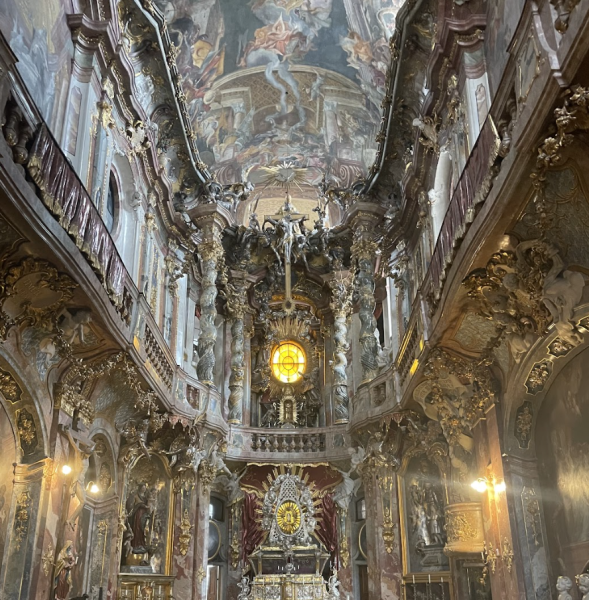“Sing to the Lord a new song, his praise in the assembly of the saints.” The Latin translation of Pitoni’s “Cantate Domino” echoed through the chambers of Engelberg Abbey in Switzerland as the Saint Anselm College Choir began their final performance during a well-traveled spring break.
Music could be heard throughout the 1,000 year old church, which had been rebuilt in the nineteenth century after a severe fire damaged much of the Abbey. Sound bounced off the Baroque-style paintings depicting the life of Mary down the center and the life of St. Benedict on the sides.
The College Choristers traveled through the countries of Austria and Switzerland. They toured the cities of Vienna, Salzburg, Zurich, Basel, and Luzern. The students were also fortunate to be able to visit the city of Munich in Germany, and Lichenstein; all four German-speaking countries.
The Euro trip was accompanied by Dr. Bermani, the director of the Choir, and Father Francis, who took a similar Choir pilgrimage when he was a student at Saint Anselm.
The pilgrimage was hosted by WorldStrides, the touring agency, and the tour guide was England’s George Hicks. Hicks received a degree in German and Italian at Oxford and found his passion for language in music. His deep understanding of the German language and the history of Austria and Switzerland was extensive and vital to the success of the trip. Hicks also serenaded the choir with his ukulele and singing skills.
The initial day started with a city tour of Vienna. The Choristers saw sights which included the Hoher Markt with the Virgin Mary’s Wedding Fountain and an Art Nouveau clock, the Altes Rathaus, the old Chancellery of Bohemia, the Clock Museum, and St. Peter’s Church.
One of the highlights of Vienna was the morning Mass at Schottenkirche.
The church acts as a Benedictine Abbey that was built by Irish monks in the 12th century. Upon walking in, we couldn’t help but look up at the magnificent paintings that drew us closer to the altar. In front of us, we could see a men’s choir practicing for the Mass with German chants, creating an euphoric atmosphere. After Mass finished, the choir was invited to a social with coffee, pastries, and many conversations. Members of the parish got to meet us and ask us about our tour in Europe.
The choir also visited the houses of both Mozart and Beethoven, during their times in the city. At the end of the day, the choir saw the Haus der Musik (House of Music), an interactive museum where visitors can conduct the Vienna Philharmonic from a virtual conductor’s podium, a view of great classical composers, and areas dedicated to a wide array of approaches to music.
The pilgrimage then made its way to Salzburg. Here the choir saw Mozart’s birthplace, the Old Square of the city, the Cathedral, and the Residenz Palace, a nineteenth century palace built by the Hapsburg rulers of the Austrian Empire. A highlight of the city tour was the Glockenspiel, an early 18th century carillon with thirty-five bells.
For the Choir, a favorite spot during the trip was Salzburg. A quaint town in western Austria, Salzburg had many unique stops. One of the highlights was the Mirabell Garden. This was the garden where Julie Andrews would sing “Do Re Mi” with the children in “The Sound of Music” in 1965. The choir sang on the same steps the characters did in the film and ran through the hedged arcs just like they did in the movie. Additionally, a view from Hohensalzburg Fortress would show the house and lake they filmed from, Leopoldskron Palace.
Then the choir traveled through the lands of Europe, traveling through four countries that day. Trekking the Rhine River, the choir visited Germany and Liechtenstein, unplanned for the Euro trip. Arriving in Switzerland the choir witnessed the beautiful Alp mountains and countryside of Switzerland. Later in the night, the bus arrived in Zurich.
In Munich, the Choir visited the St. Boniface Abbey, a church renovated after being bombed in World War Two. The church is the grandmother of the Saint Anselm Abbey. Throughout the trip, the choristers saw the beauty of the German-speaking countries but were also reminded of the great suffering there as well. The tour guide educated the students on the Holocaust memorials in Austria. In Munich, the choir saw the headquarters of the national socialist party, which has been converted into a dance and theater school.
The next day, the choir traveled to Zurich. After a walking tour around the city and scenic views of the Rhine River, we ate lunch at various cafes and restaurants, shopped at the local stores, and explored various sites around the city.
After, we visited the city of Basel. The tour saw Basel Minster, Marktplatz, Geltenzunfthaus, fountains, and Old Town. The choir also went to Munsterplatz, a church on a hill overlooking the Rhine. At one time, it was a Catholic church but was converted into a Protestant church during the Reformation. It was a very large yet beautiful church, so beautiful that the choir snuck in a surprise short song to hear the acoustics.
On our last day, the choir went to Luzerne, a small town sitting in the north-western region. There were many sights to see, including scenic views of the Alps, the Jesuit church in the downtown area, chocolate stores, and a covered bridge. Finally, the choir ended their tour at Engelburg Abbey before returning to the hotel for a long day of travel back home.
“Until all the world adore His sacred name.” The audience at Engelburg erupted in applause and the members of the choir smiled, in a storybook ending to a life-changing trip.



